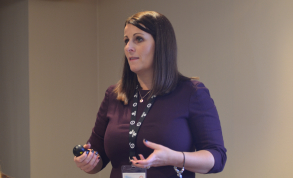HFMA 2018: Turning costing data into intelligence
This was the key message from a workshop on using patient-level data on the first day of HFMA 2018 – the association’s annual conference in London. Lucy Billington (pictured), assistant finance director of Lancashire Teaching Hospitals NHS Foundation Trust, told the session that costing information needed to be seen as intelligence rather than data – and engaging clinicians was the key to this transformation.
The trust started changing its approach to costing in 2015/16 to help it achieve significant levels of cost improvement. However it recognised that it needed to improve the quality of costing data – which at the time was achieving around a 50% rating in the old materiality and quality score – before it could really use it to drive improvement.
‘We weren’t sharing the data because the MAQ score was so low,’ she said. With board-level backing, the trust then set about improving its costing processes. This involved expanding the costing team, creating a cross-functional costing and income team, moving to quarterly reporting and involving clinicians to validate the data. The trust also signed up to be an early implementer of NHS Improvement’s Costing Transformation Programme.
These processes led to a major improvement in the quality of data (up to 80% in in the MAQ and subsequent Costing Assessment Tool rating) and on the back of this the trust launched a number of service reviews. It identified priority areas using a portfolio matrix to focus on services with a high reference cost index and a deficit on service line income.
Dashboards included in new data packs pulled together key metrics on workforce, and opportunities from the Carter productivity and Getting it right first time programmes. ‘But the biggest thing for clinicians was looking at the top 15 loss making patients,’ she said. ‘This found lots of opportunities for cost and income improvement.’
Examples included a coding oversight that meant best practice tariffs were not being received for trauma patients – with a significant potential benefit to the trust. But in other cases, the reviews highlighted variations in clinical practice. A clinically led review has now established a firm pathway for some neurosurgery patients that delivers a more consistent length of stay.
A further round of reviews, this time using Model Hospital data, again found that the data that most engaged clinicians was information on loss making patients. Again the reviews led to the identification of apportionment errors and incorrect coding, but also patient pathway improvements – in particular shortening pre-operative lengths of stay in a service that was an outlier in this area.
‘In both approaches, loss-making patient data was the key to engaging clinicians,’ said Ms Billington. Clinicians could refer back to actual events for each patient and understand where costs were justified and where there were opportunities to improve the pathway.
‘We’ve had a number of successes,’ she told the workshop. ‘We’ve seen improvements to costing methodologies ad changed apportionments with clinical input. We’ve identified real savings for service lines and used the data to set cost improvement targets and support business cases. And we’ve improved clinical and executive team engagement. However there is still much more to do.’
Related content
We are excited to bring you a fun packed Eastern Branch Conference in 2025 over three days.
This event is for those that will benefit from an overview of costing in the NHS or those new to costing and will cover why we cost and the processes.